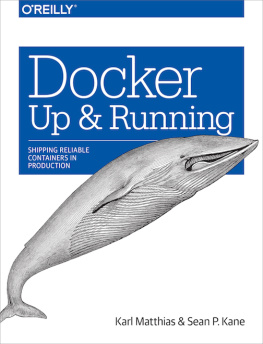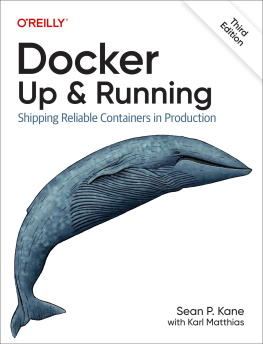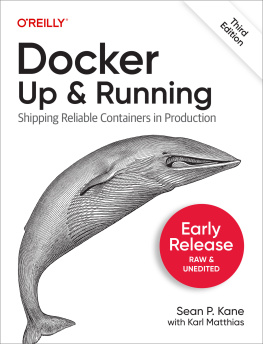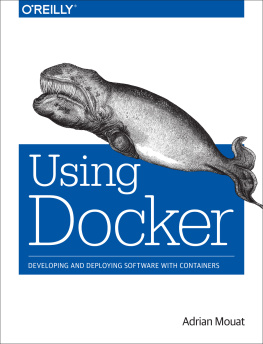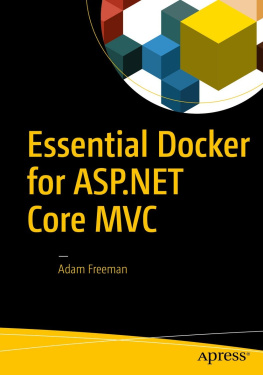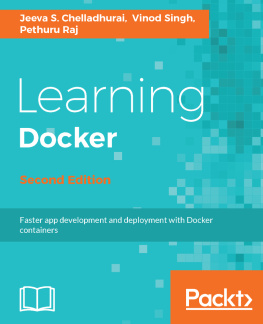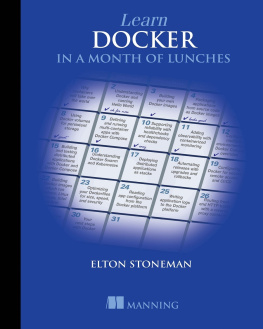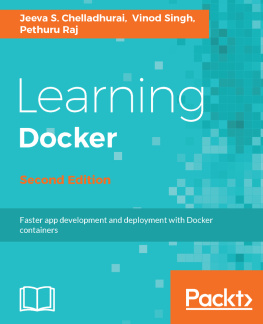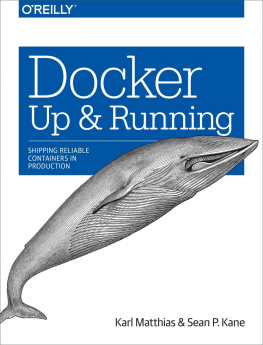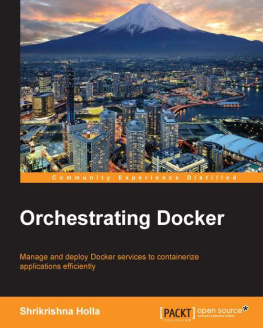For my wife and children, who make everything worth it.And my parents, who pointed me towards the beautiful intersection between logic and passion.
Sean P. Kane
For my Mom, who got me to read, and my Dad, who read to me. And for my wife and daughters, who are my bedrock.
Foreword
Everything old is new again is a commonly heard phrase that has described everything from fashion, to politics, to technology. It is also an apt statement when it comes to Linux containers, and I would expand upon it to say, Everything old is new againand nonetheless exciting.
Containers have been available for many years in Linux distributions but theyve seldom been used because of the complexity required to build something that worked. Thus historically, Linux container implementations have been purpose-built with a single objective in mind, which made additional requirements like scaling and portability challengingif not impossibleto implement.
Enter Docker, which has created phenomenal momentum in unlocking the value of Linux containers by combining a standardized packaging format with ease of use, to turn processes that were once esoteric and incomprehensible into consumable capabilities for developers and operations teams. Docker, in a sense, has created a Renaissance for Linux containers, driving an ever-growing wave of interest and possibility, leading to rapid adoption of the technology. Its helping technology teams everywhere realize the benefits of application portability, simplified integration, and streamlined development as promised by Linux containers for some time but historically trapped behind layers of complexity.
Through Docker, Linux containers have catapulted into an elite club of truly disruptive technologies with the power to transform the IT landscape, related ecosystems, and markets. In the wake of this emergence rises a wave of innovation that demonstrates Linux containers potential to dramatically change application delivery across a variety of computing environments and platforms while leveraging a spectrum of tehcnical skill sets.
Innovation doesnt necessarily mean the introduction of a completely new, world-altering technology. Like many of its predecessors, Dockers success stands on the shoulder of giants. It builds on years of technological innovation and Linux evolution that now provides the core capabilities which Docker makes easy to use. The maturity of the Linux capabilities exploited by Docker can now be replicated in other operating systems, allowing Docker to function beyond its Linux roots.
Docker is facilitating a disruptive change in the minds of technology professionals. It has reshaped views on which aspects of application development and delivery, as well as infrastructure management should be considered table stakes versus complexity that requires technology or process solutions. As is typical for the early adoption phase of any disruptive technology, these perspective changes aim at whats right in front of us, often oversimplifying and ignoring relevant aspects but the potential for Docker and Linux containers goes much deeper than simply redefining development. It is redifing the very nature of the application itself.
The obvious impact of Docker and the ease of use it brings to Linux containers is the possibility to redefine the organizational divide between business, application development, and IT infrastructure teams. In a sense, Docker provides a tangible technology for implementing DevOps, which is the merger (or at least an armistice) between the often competing teams of development and operations. Containerization modernizes IT environments and, at an organizational level, allows for proper ownership of the technology stack and processes, reducing handovers and the costly change coordination that comes with them.
Dockers role as both a packaging format for the application and a unifying interface and methodology enables the application team to own the Docker-formatted container image, including all dependencies, while allowing operations to retain infrastructure ownership. With a standardized container infrastructure in place, the IT organization can then focus on building and managing deployments, meeting their security standards, automation needs, skill levels and ultimately cost profile, all without losing the ability to hold the application team accountable for the security and cost impact of their code that is deployed inside the container.
Docker also brings with it greater efficiencies of scale and performanceby shrinking application footprints through Docker-formatted containers, system-level dependencies are reduced to a bare minimum, often dozens-to-hundreds of megabytes in size. Compare this to traditional virtual machine images, which typically consume gigabytes of storagebut when you factor in performance, it goes beyond simply being innovative and becomes truly disruptive.
Starting a container takes millisecondsquite a difference compared to the minutes most users experience with virtual machines. Deploying container images is faster if less data needs to travel over networks and storage fabrics, so modern, elastic applications with frequent state changes and dynamic allocation of resources can be built far more efficiently if the rollout of changes can happen extremely quickly and resource needs can be fulfilled in real time.
But perhaps the greatest innovation and most significant impact delivered by Docker and Linux containers is the fundamental change to application consumption. The monolithic application stack as we know it can be broken into dozens or even hundreds of tiny, single-minded applications that, when woven together, perform the same function as the traditional application. The benefit, however, is that these pieces can be rewritten, reused, and managed far more efficiently than monolithic applications, delivering a truly composite application built entirely of microservices.

